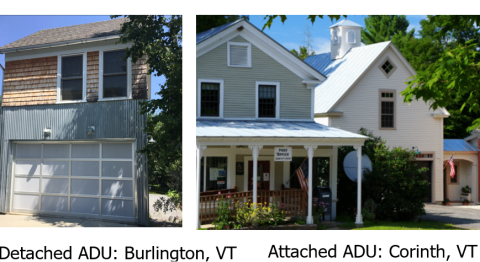Vermont sealed the approval of legislation this week to ease the challenges faced by residents seeking to add an accessory dwelling unit (ADU) to existing residential properties.

ADUs are small houses or apartments that exist on the same property lot as a single-family residence. This once-popular home type is re-emerging as an affordable and flexible housing option that can help meet the growing needs of older adults and young families.
Effective immediately, Vermont municipalities may not prohibit the development of ADUs based on their size, as long as the ADU is no larger than 30 percent of the total habitable floor area of the home or 900 square feet whichever is greater. In addition, ADUs may not be prohibited based on the number of bedrooms they contain.
Another expansion provided under the legislation signed this week is that owners of properties containing an ADU must be allowed to choose to live in either the original home or the ADU.
Until this week, Vermont municipalities were permitted to require that ADUs be no larger than 30 percent of the total floor area, have no more than 1 bedroom and that owners live in the original home. Municipalities may continue to require that properties with ADUs meet other existing standards, such as sufficient wastewater capacity.
ADUs have benefits such as providing necessary housing for parents, adult children, grandchildren, and other loved ones, as well as providing a way to downsize one’s own home while a tenant or family member resides in the second unit.
ADUs can also generate rental income to help homeowners cover mortgage payments or simply make ends meet. The income provided by an ADU tenant can be especially important for older people on fixed incomes. Twelve percent of Vermont homeowners pay more than half of their income for their housing costs, such as mortgage payment, property taxes and insurance. ADU rental income could help make housing costs more affordable for these 21,000 homeowners, reducing the likelihood of foreclosure in the future and deferred home maintenance.
The Vermont Housing Data website’s Housing-Ready Toolbox contains materials to help municipalities incorporate ADUs in their housing affordability strategies. The site’s Community Profiles also give towns the latest information about homes used as short-term rentals. Statewide, about 5,000 of the Vermont’s 322,000 homes (1.6%) were used consistently as short-term rentals in August 2020.
Vermont's expanded ADU requirements are included in S.237 (ByLaw Reforms for Infill & Housing: An act relating to promoting affordable housing). A summary of the entire statute will be available soon through the Vermont Department of Housing and Community Development.
Pictured: Excerpt from Gentle Infill by Vermont Department of Housing and Community Development.

